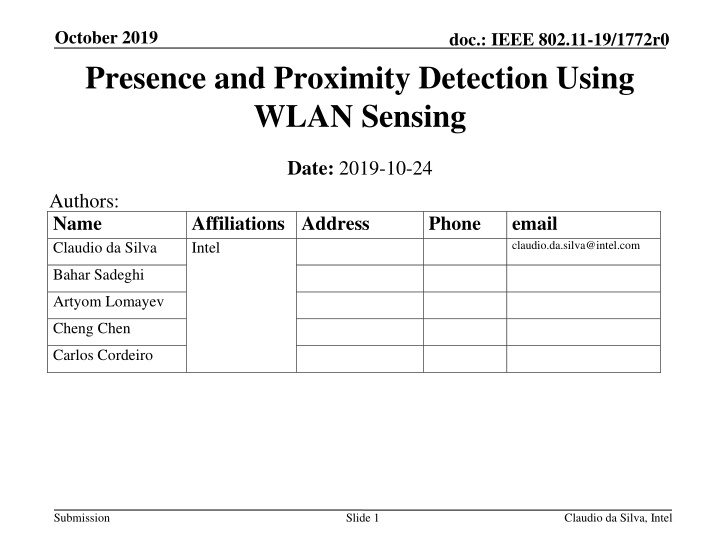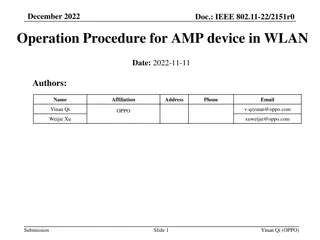Presence and Proximity Detection Using WLAN Sensing
This document discusses the utilization of WLAN sensing for presence and proximity detection, focusing on identifying the presence of individuals, determining the number of people, monitoring well-being, and detecting human subjects in various environments. It explores use cases in smart home monitoring, security, healthcare, and more. The example provided illustrates motion detection through eigen-decomposition of covariance matrices.
Download Presentation

Please find below an Image/Link to download the presentation.
The content on the website is provided AS IS for your information and personal use only. It may not be sold, licensed, or shared on other websites without obtaining consent from the author.If you encounter any issues during the download, it is possible that the publisher has removed the file from their server.
You are allowed to download the files provided on this website for personal or commercial use, subject to the condition that they are used lawfully. All files are the property of their respective owners.
The content on the website is provided AS IS for your information and personal use only. It may not be sold, licensed, or shared on other websites without obtaining consent from the author.
E N D
Presentation Transcript
October 2019 Presence and Proximity Detection Using WLAN Sensing doc.: IEEE 802.11-19/1772r0 Date: 2019-10-24 Authors: Name Claudio da Silva Affiliations Address Intel Phone email claudio.da.silva@intel.com Bahar Sadeghi Artyom Lomayev Cheng Chen Carlos Cordeiro Submission Slide 1 Claudio da Silva, Intel
October 2019 doc.: IEEE 802.11-19/1772r0 Introduction Previous presentations on WLAN sensing given at WNG and at SENS TIG partially addressed usage models. For example, Proximity, gesture recognition, gaming control, liveness, facial/body recognition, area sensing/presence detection, robot 3D vision [1] Audio with user tracking, location in store [2] In this presentation, we look into presence detection and proximity detection into more detail. We also discuss performance requirements/metrics and the use of alternative (non-WLAN-based) technologies. Submission Slide 2 Claudio da Silva, Intel
October 2019 doc.: IEEE 802.11-19/1772r0 Presence Detection Goal is to enable a WLAN device or WLAN network to, for example, Identify the presence of people (1 or more) Determine number of people Determine if subject is human Monitor well-being of each person Determine coarse location (passively) in a given environment (home, enterprise, vehicle ). WLAN is used for both data transfer and sensing. Important differentiator to other technologies. For example, could be used to network multiple sensors and/or to transfer data to the cloud. Proprietary solutions already exist in the market. Submission Slide 3 Claudio da Silva, Intel
October 2019 doc.: IEEE 802.11-19/1772r0 Presence Detection Use Cases Smart home, building monitoring Detection of presence of users within a house/room/etc., including number of users Air condition capacity controlled by number of people Activate light if there are people in the room Security Identify intrusion in pre-defined areas Detect presence in the presence of smoke Health care Fall detection Remote vital sign monitoring Child presence detection Submission Slide 4 Claudio da Silva, Intel
October 2019 doc.: IEEE 802.11-19/1772r0 Presence Detection Example [3] Example: Detect motion and identify where (e.g., in which room) it happens. Core algorithm makes use of eigen-decomposition of the covariance matrix of multiple channel estimates obtained over time to determine motion. Relies on transmit/receive STA diversity. Channel estimates Covariance estimation Eigen- Likelihood Conditioning decomposition Submission Slide 5 Claudio da Silva, Intel
October 2019 doc.: IEEE 802.11-19/1772r0 Presence Detection Example [3] No O PR B1 O + PR O + B1 PR + B1 No 1 0 0 0 0 0 0 O 0 1 0 0 0 0 0 PR 0 0 1 0 0 0 0 B1 O + PR 0 0 0 0.9895 0 0 0.0105 0 0 0 0 0.9999 0 0.0001 O + B1 0 0 0 0.0006 0.0016 0.9874 0.0103 PR + B1 0 0 0 0.0074 0.0001 0.0245 0.9680 Avg. Probability Correct Classification 100.00% 90.00% 80.00% 70.00% 4TX,1RX 4TX,2RX 4TX,3RX Submission Slide 6 Claudio da Silva, Intel
October 2019 doc.: IEEE 802.11-19/1772r0 Proximity Detection Goal is to enable a WLAN device to detect the presence of a potential user in its vicinity. Use cases Smart platforms Emerge/go to sleep mode (screen power save) Screen lock Security Screen privacy screen Smart home/building, home/building monitoring Automatically turn on lights, call elevator, when a person arrives Improved user experience Trigger other applications such as gesture and facial recognition Proprietary solutions already exist in the market. Submission Slide 7 Claudio da Silva, Intel
October 2019 doc.: IEEE 802.11-19/1772r0 Proximity Detection Example [4] Relies on transmit STA diversity. Ability to differentiate motion close to transmit points from motion close to sensing device. Office Bathroom Play room STA 1 1 Hallway 81 55 108 0 - 30 Start Bedroom 1 Master Stairs STA 2 2 4 150 2 4 127 3 End 170 Bedroom 2 AP 145 3 1 Bathroom Closet No motion STA 3 Measure of channel variability refer to [4]. Submission Slide 8 Claudio da Silva, Intel
October 2019 doc.: IEEE 802.11-19/1772r0 Performance Metrics 1/2 (Note: The material below and in the next slide builds upon definitions presented in [2].) Sensing range: Maximum distance from a sensing device to the subject. Example: <5m indicates that the maximum distance a sensing device would reliably detect/track a subject is 5m. Sensing coverage: Required coverage area of a sensing network. Example: <10m2 indicates that the area in which a sensing network would reliably detect/track a subject is 10m2. Detection/Classification Accuracy: Detection/classification accuracy is specified in terms of the average probability of correctly detecting/classifying one or more of the following a) Presence, b) Gesture (among a pre-defined set of gestures), c) Specific body activity such as breathing rate, and d) Human vs animal vs object. Example: >95% indicates that a given sensing application satisfies its detection/classification requirements more than 95% on average. Number of subjects: Required number of subjects (people/objects ) the sensing device network is capable of detecting/tracking at the same time. Example: <5 indicates that a given WLAN sensing application is able to reliably track 5 subjects simultaneously. Submission Slide 9 Claudio da Silva, Intel
October 2019 doc.: IEEE 802.11-19/1772r0 Performance Metrics 2/2 Latency: Maximum or average time necessary for a sensing device/network to produce an output after an event of interest happens. Example: 100ms indicates that a sensing device/network requires at most, or on average, 100ms to, for example, detect a person when entering a pre-specified area. Field of View: Angle through which a sensing device is sensitive to an event of interest. Example: 50 indicates that a given sensing device reliably classifies gestures performed up to 50 from a given reference (plane perpendicular to the screen, for example). Refresh Rate: Maximum or average time necessary for a sensing device/network to update its sensing output. Example: 100ms indicates that a given sensing application updates its output on average, or at most, every 100ms. Expected Location Accuracy: Maximum difference between the actual and sensed location/position of a subject. Example: <1m indicates that a given sensing application using 2.4/5 GHz devices is able to reliably estimate the location of a subject with maximum error equal to 1m. Submission Slide 10 Claudio da Silva, Intel
October 2019 doc.: IEEE 802.11-19/1772r0 Performance Metrics - Examples Presence detection Accuracy Exp. number of simultaneous subjects Usage model Sensing range FOV Latency Refresh rate Location accuracy Velocity accuracy Detection accuracy Presence detection <3m <10m TBD < 50cm @ 90% N/A >95% <1s TBD <= 5 AC Control <10m (room) < 50cm @ 90% N/A >95% <1s TBD <= 10 Light Control <10m (room) < 50cm @ 90% N/A >95% <1s TBD <= 10 Fall detection <10m (room) < 50cm @ 90% N/A >95% <1s TBD <= 10 Passengers in the car <3m (car) < 30cm @ 90% N/A >95% <1s TBD <= 5 Submission Slide 11 Claudio da Silva, Intel
October 2019 doc.: IEEE 802.11-19/1772r0 Performance Metrics - Examples Proximity detection Accuracy Exp. number of simultaneous subjects Usage mode Sensing range FOV Latency Refresh rate Location accuracy Velocity accuracy Detection accuracy Phone screen Few cm (R) <5mm N/A >99% <100ms 100msec 1 50 Trigger gesture or other application <0.5m (R) <10cm N/A >95% <100ms 100msec 1 50 PC/TV screen Walk-in: 1000ms Walk-away: 2000ms 1.5 m - 4m (R) < 50cm N/A >95% 100msec 1 60 Submission Slide 12 Claudio da Silva, Intel
October 2019 doc.: IEEE 802.11-19/1772r0 Advantages WLAN-based Sensing If the application requires data transfer, such as to support The networking of multiple sensors Central/cloud processing Sensing application triggering an action/notification (e.g., phone app) WLAN sensing has an advantage over other modes since data transfer and sensing are performed with the same hardware. Most modern electronic platforms, such as smartphones, laptop computers, and even appliances, already include WLAN. Other sensors, such as radars or PIRs, require integration and occupy valuable area. Excellent WLAN coverage in typical residential and enterprise environments. Number of WLAN devices in such environments is large and growing, enabling receive/transmit station diversity. Improved performance by making use of other WLAN features. Submission Slide 13 Claudio da Silva, Intel
October 2019 doc.: IEEE 802.11-19/1772r0 Other Sensing Technologies Proximity and presence detection can be implemented with other technologies, including Infrared and visible light sensors (e.g., PIR, LIDAR) Ultrasonic and microwave radars (e.g., FMCW) Acoustic sensors Cameras Accelerometer (e.g., vibration), magnetometer (e.g., for road traffic monitoring) The right technology depends on the application and platform of interest. WLAN-based sensing is attractive because Good range, doesn t require LoS, works through walls and smoke Does not require light, works in the dark Not computationally intensive (when compared to cameras, for example) No privacy concerns Also useful for applications that make use of sensor fusion. Submission Slide 14 Claudio da Silva, Intel
October 2019 doc.: IEEE 802.11-19/1772r0 WLAN Sensing: Standard To more efficiently support sensing and to enable more use cases, standards support is required. See WNG discussions: [1], [3]-[7]. WLAN sensing-related aspects that require standard support include Negotiation of sensing parameters and schedule Determine transmission characteristics of PPDUs used for sensing Power save (e.g., not rely on the opportunistic reception of packets) Enable transmit/receive station diversity Protocol flow that efficiently supports unique and fundamental characteristics of Wi-Fi sensing Submission Slide 15 Claudio da Silva, Intel
October 2019 doc.: IEEE 802.11-19/1772r0 Conclusions WLAN-based sensing has multiple advantages over other sensing technologies Various conditions (light/no light, smoke ), relatively low computational complexity, long range, single-device and networked solutions Common data transfer and sensing hardware Improved performance by relying on other 802.11 features Well established and widely adopted technology/protocol A large number of use cases can be supported by WLAN sensing, each with possibly unique requirements. We suggest for the group to start developing a usage model document. Submission Slide 16 Claudio da Silva, Intel
October 2019 doc.: IEEE 802.11-19/1772r0 References [1] Wi-Fi sensing in 60GHz band, IEEE 802.11-19/1551r1. [2] Usage models for WLAN sensing, IEEE 802.11-19/1725r0. [3] Wi-Fi sensing: Cooperation and standard support, IEEE 802.11- 19/1416r0. [4] Wi-Fi sensing: Usages, requirements, technical feasibility and standards gaps, IEEE 802.11-19/1293r0. [5] Wi-Fi sensing, IEEE 802.11-19/1164r0. [6] Wi-Fi sensing - Follow up, IEEE 802.11-19/1293r0. [7] 802.11 sensing: Applications, feasibility, standardization, IEEE 802.11- 19/1626r1. Submission Slide 17 Claudio da Silva, Intel























